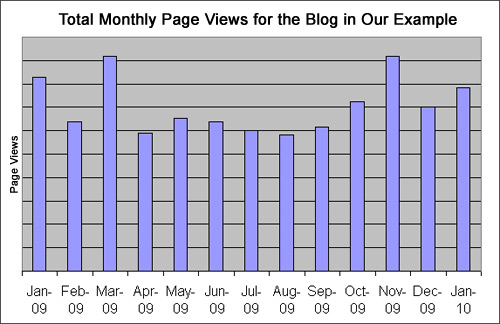If you work for a business media brand, have you focused on which parts of your ‘audience’ convert? Which open your enewsletters, come back to your website twice a month or more, comment on your posts, follow you on Twitter, sign up for your webinars, and show up to industry events?
Are you focusing on the many segments of your audience – those with specific goals, specific behaviors, specific roles – or are you treating everyone on the planet the exact same way?
Focusing intently on the segments of your audience, allows you to optimize your product to increase engagement and drive business.
Filtering Out Non-Core Audience
Clearly, you don’t necessarily want to ‘ignore’ segments of your audience, but you do need to understand what the segments are and use that information to prioritize and customize your product focus.
Let’s take a look at a really simple example.
One of the blogs I work with has a sizable readership, lots of updates & comments and has become a leading blog in its niche. Here is its growth rate for page views from Jan 2009 to Jan 2010:

I can’t share specific numbers, so just imagine anything in the Y axis, let’s say 100,000 page views per month to make it easy. This blog is not a model of consistent growth, but their metrics are strong for it’s brand and niche.
Now, if I look at this blog’s most popular individual blog post each month, it is always the same:
- A blog post that is now two years old, published in early 2008.
- This blog post was interesting to the blog’s readership, but largely off-topic.
- The amount of page views it receives each month dwarfs that of other individual pages. It is the most popular blog post by a wide margin.
- In January 2010, it accounted for 22% of total traffic for the blog.
- 99% of this traffic came from Google.
- The average viewing time for the article is low, typically measured in seconds, such as 22 seconds for a given month. Lower than we would like to see for a blog post of this length. (it was a pretty long blog post)
Let’s chart out the percentage of page views that this top blog post saw each month:

So, the percentage of traffic it received has declined, but it has always captured a large chunk of overall traffic. You begin to see where this single blog post can skew one’s perception on the growth of the blog though. If you compare January 2009 to January 2010, you notice that the blog post received 10% less traffic. But without digging into the metrics, one may mistakenly conclude that interest in the overall blog decline by 10%, when that’s not really the case.
Breaking it out like this helps you identify how your audience really behaves, which parts of your blog are supporting your goals and which aren’t. This allows you to take proper action – putting your scant resources in just the right places.
Just for kicks, let’s see the shape of the chart if we remove all page views from the top blog post:

Not a huge change from the first chart in terms of it’s shape, but the scale of the page views would be lower, if you could see the values of the Y axis. Which you can’t. Sorry about that.
How Does Google Images Affect Your Web Traffic?
Do you include images in your blog posts and articles? Have you ever looked at referrers who came from Google Image Search? Have you ever filtered out which search keywords delivered traffic and noticed they were folks looking for images, not text-based content? In other words: was the traffic an unintended effect, bringing in an unengaged audience member, whose activity is treated the same as someone who read your article from start to finish? The same as someone who knows your brand & loves your brand?
I have seen this again and again on blogs – that a particular image used within a blog post drives a significant amount of traffic. Often, the "time spent" metrics are incredibly small, like 5 seconds on average. These are not people who will be coming back either, especially as blog posts use a variety of images to engage readers, not necessarily images that relate to the topic being written about, except as metaphor. (Here’s an example.)
Do you segment out your readers by referer, by those who visited more than twice a month, by a variety of other factors? Do you combine metrics, track over time and make adjustments to your products accordingly? Sounds like a lot of work, but it can be surprisingly easy to get started.
How to Find Your Customer Segments
To get a clear picture of your audiences behavior and how well your content & marketing is performing, you need to weave the following two things into the fabric of your editorial process:
- Research
- Web Analytics
I know, it sounds boring, it sounds like you are taking the soul out of your creative efforts. But you’re not, really. Research and web analytics bring you closer to two things:
- Your Audience
- Reality
If you aren’t constantly learning about your customer’s behaviors and preferences, then who is all this work for? How can you best manage your resources? How can you improve?
As for reality, this is both the opportunity and challenge that the web has given us. There is a TON of data at our disposal. You don’t want to get weighed down with it – you want to use it to your advantage, and not just for vanity metrics.
If you work in business media, serving a professional niche audience of experts, then you may want to focus on engagement and experience for the few, not the quantity of the many. So instead of measuring page views of a single article in a month, focus on driving higher click-through’s from the newsletter, more click-through’s, longer time-spent, more comments, more sign-ups to your newsletters.
You know: activities that mean people are engaged with you, that people love you – the kinds of things that solve needs and drive business forward.
An article from Read/Write Start from this week deals with similar issues: The Death of the Pageview.
What I am hearing more and more people talk about is the value of a small, but engaged, newsletter list. Not a list with 20,000 names, but a list with 1,000 names, but consisting 100% of people who desperately want what you offer. That you would take active efforts to weed out people who don’t love you. Likely, you don’t need to go that far by any measure, but it is an interesting concept to think about.
Focusing on Customer Segments & Diversifying Revenue Streams
When media, especially business media, talks about paywalls and paid content, they need to look critically at audience segments in order to identify need, decision-making cycles, and how that will shape their product and marketing efforts.
Likely, a stable business model will not be dependent upon a single price with all-you-can-eat access to content. It will instead be dependant on a variety of products, revenue streams and audience segments. For business media, it’s all about the critical needs of a niche market.
Even for consumer media, if you treat 100% of your audience the same, as if they all have the same identity, goals and needs, then you will likely be consistently perplexed as to why growth and a stable business model is difficult to achieve. You can keep sending emails, keep posting stories, and keep trying to get people to register for events, relying on brute force, instead of truly listening to and responding to specific audience needs.
Seth Godin recently talked about this topic; his conclusion:
"In the race between ‘who’ and ‘how many’, who usually wins–if action is your goal. Find the right people, those that are willing to listen to what you have to say, and ignore the masses that are just going to race on, unchanged."
Clearly, I don’t have the answers, and quite frankly, no one does. But it’s always helpful to bounce ideas off of someone else. If there is any way you think I can help, send me a note: dan@danblank.com. You can also follow me on Twitter: @DanBlank


Interesting post, Dan. Couldn't agree more on the important distinction between “vanity” and what I would call “pragmatic” analytics. But there is still, I would argue, value in the relationships that a brand can build over time with, for example, newsletter recipients that haven't yet clicked through and purchased something. Difficult to measure, but valuable nonethless. Display advertising versus direct response redux.
Matthew,
AGREED, good point. People react differently to brands and their need/preference changes over time. Having that ambient awareness of them during the down time is important. Thanks!
-Dan